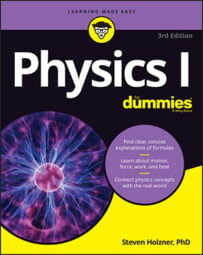Thanks to the principle of conservation of mechanical energy, you can use physics to calculate the final speed of an object that starts from rest.
“Serving as a roller coaster test pilot is a tough gig,” you say as you strap yourself into the Physics Park’s new Bullet Blaster III coaster. “But someone has to do it.” The crew closes the hatch and you’re off down the totally frictionless track. Halfway down the 400-meter drop, however, the speedometer breaks. How can you record your top speed when you get to the bottom?
No problem; all you need is the principle of conservation of mechanical energy, which says that if the net work done by nonconservative forces is zero, the total mechanical energy of an object is conserved. You know that
You can make this equation a little easier. Your initial velocity is 0 and your final height is 0, so two of the terms will drop out when you plug in the numbers. You can then divide both sides by m, so you get

Much nicer. Solve for v2 by rearranging the terms and taking the square root of both sides:
Then plugging in the numbers gives you the speed:
The coaster travels at 89 meters/second, or about 198 miles/hour, at the bottom of the track — should be fast enough for most kids.

